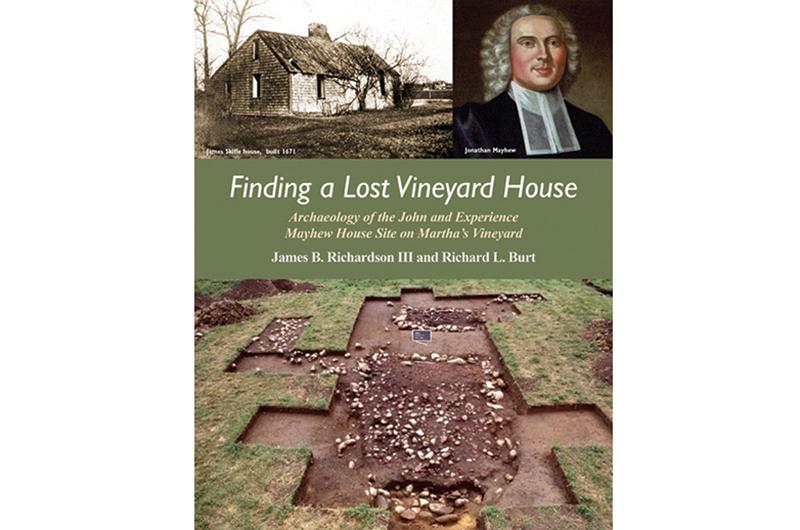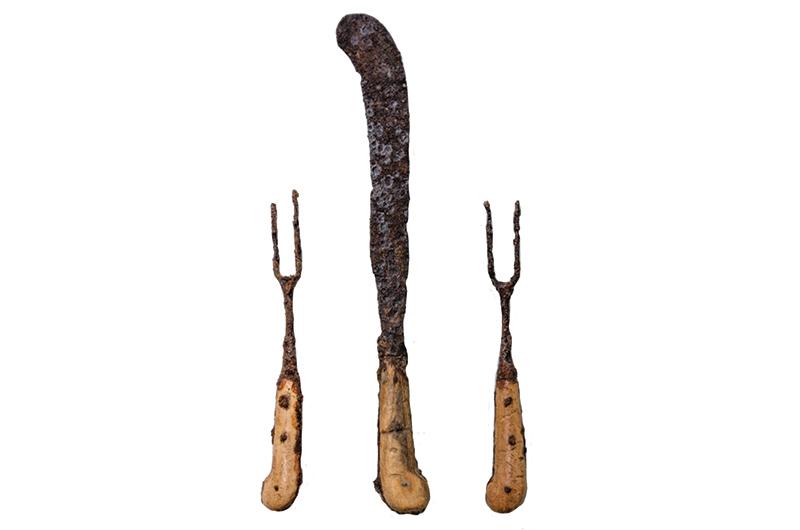In the mid-1980s amateur archeologist and historian Dick Burt of West Tisbury was looking for arrowheads at the late David Douglas’s Rainbow Farm on the West Tisbury–Chilmark town line, where the Grey Barn is situated today. Not only were there arrowheads there, he discovered as he looked at the ground, but bits of blue-gray ceramic and a corroded coin from 1723. Might the ceramic fragments have been part of cups or mugs centuries before, he wondered? Could he be at the site of the original seventeenth-century farm of John Mayhew, and, later, of his son, Experience?
John Mayhew’s grandfather, Thomas, was the first English colonist on the Island, arriving in 1641 and settling in Great Harbor (now Edgartown). His son, Thomas Jr., became a missionary to the Wampanoags but was lost at sea on a return trip to England when he was only thirty-six. A bereft Thomas Sr. not only brought up his grandson, John, at his home in Great Harbor, but took his son’s place as a missionary to the Island’s Wampanoag population. John, too, became a missionary, but moved from Great Harbor to Chilmark hoping to augment his missionary income by farming. What became of his original farmhouse was and is a mystery, though it may have been moved to Quansoo or Quenames in Chilmark.

A curious Burt went back to the Douglas farm to try to determine what might have been on that site. Before long he got in touch with his boyhood friend Jim Richardson, a longtime East Chop seasonal resident and an emeritus professor of anthropology at the University of Pittsburgh. Richardson had gotten a taste for anthropology in his youth, digging for Indian artifacts at the head of the Lagoon with E. Gale Huntington, a history teacher at the Tisbury High School and later the regional high school when it formed, and an amateur archeologist.
Soon Burt and Richardson were talking about writing a book and serious archeological digging got under way with professionals involved. Some thirty-six years later, Discovering a Lost Vineyard House: Archaeology and History of the John and Experience Mayhew House Site on Martha’s Vineyard has been published by the Martha’s Vineyard Museum ($44). For all but the most committed readers it will not be cover-to-cover reading, but it is full of photos and fascinating glimpses of the earliest days of European presence, not just from the site in question but from around the Island. On almost any page you dip into you’ll learn something you didn’t know.
A search for animal bones on the site, for instance, revealed relatively little evidence of fish or shellfish having been popular among the early English, who preferred chicken, sheep, and goat meat. The authors point out that venison, a staple of the traditional Wampanoag diet, was hardly available because the English had rapidly cut down the forest in order to graze sheep.
We also learn that only two historic beads of wampum are known to have been found on Martha’s Vineyard. One was found at the old Hornblower property in Aquinnah, and the other not far away in a shell heap at Squibnocket Beach. Despite the availability of raw materials, the Vineyard Wampanoag, the authors (citing Charles Banks) say, “were not involved with wampum production used in the fur and deer-hide trade and did not use wampum as money to purchase English goods.”

As befitting an archeologic treatise, there are illustrations of old tools, cutlery, hinge fragments, dig sites, coins, beads, pipes, curtain rings, kettle fragments, and clothing, including a 1705 wedding vest of Jabez Athearn, son of Simon Athearn, a landowner prominent in Vineyard politics. It is of yellow brocaded silk on the front and cotton flax on the back.
There are fragments from paper records as well, gleaned from hours Burt spent at the Dukes County Courthouse studying eighteenth-century probate court and registry of deeds documents. We learn that in 1720 Robert Cathcart’s West Tisbury store on Mill Hill (now Brandy Brow Hill opposite Alley’s General Store) had in its inventory “a barrel of powder and 5 lbs of gun powder and 7 gross and 7 doz. gun flints.”
Cathcart, who was born in Scotland in 1663 and died in Boston in 1718, and for whom Scotchman’s Lane and Bridge in West Tisbury may have been named, was, the probate court records suggest, “a notorious merchant who sold alcohol to the Wampanoag and was called a shameless liquor peddler. He had the largest number of Wampanoag in debt to his store of any Island merchant….Only fifty were debts of non-Wampanoag and included the desperate debt of Elizabeth Mayhew, the wife of John Mayhew and mother of Experience Mayhew.”
She probably could have used, in other words, that 1723 coin Burt found some 250 years later while prowling around her old homestead on the Chilmark line looking for arrowheads.




